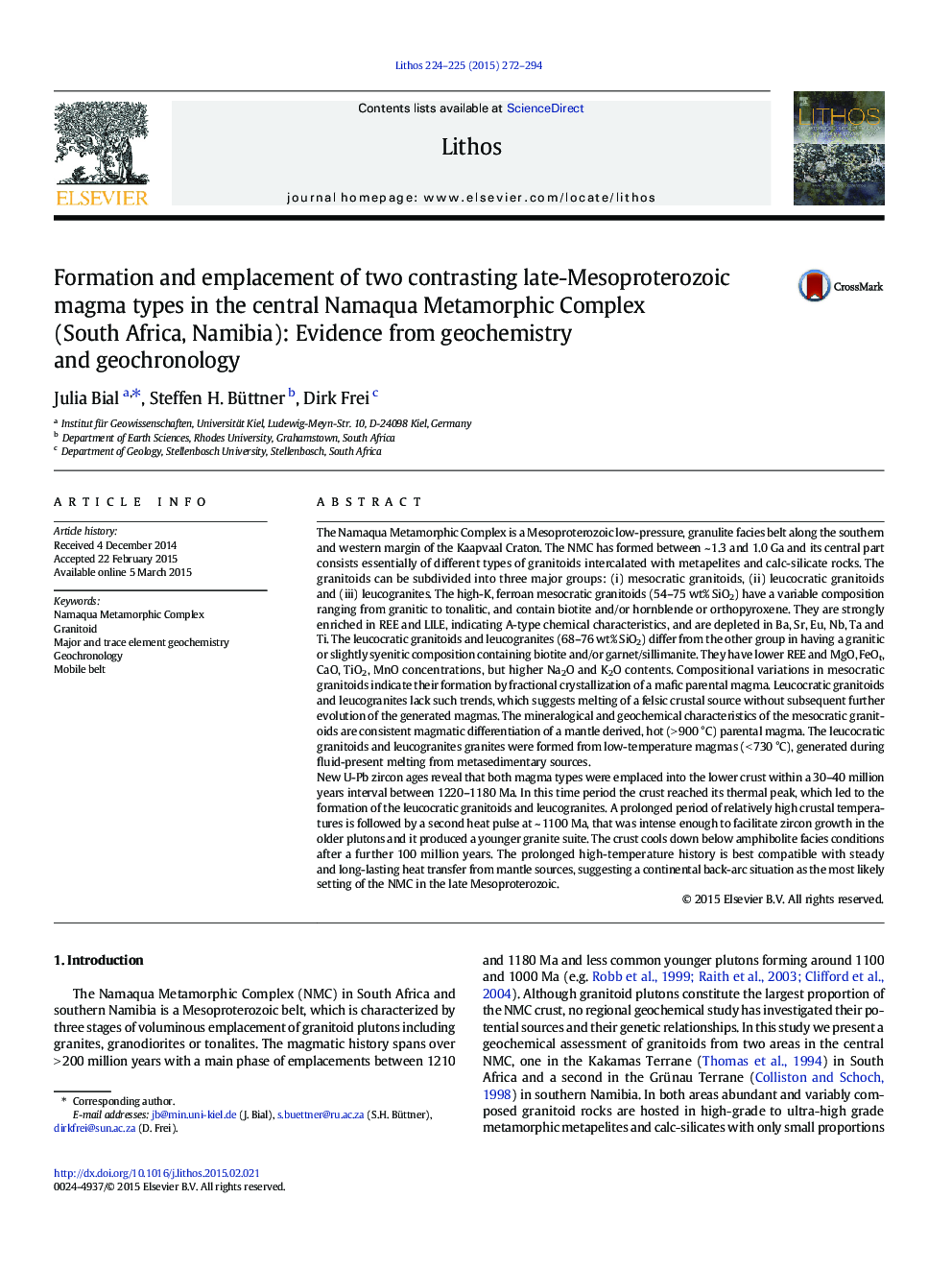| کد مقاله | کد نشریه | سال انتشار | مقاله انگلیسی | نسخه تمام متن |
|---|---|---|---|---|
| 4715739 | 1638665 | 2015 | 23 صفحه PDF | دانلود رایگان |
• We investigated granitoid rocks occurring in the Namaqua Metamorphic Complex.
• One type of magmas is interpreted as secondary products of primary mantle magmas.
• The other type formed by fluid-present partial melting of sedimentary crustal sources.
• Both magmas were formed and emplaced between 1220 and 1180 Ma.
• The most likely geotectonic environment is a continental back-arc mobile belt.
The Namaqua Metamorphic Complex is a Mesoproterozoic low-pressure, granulite facies belt along the southern and western margin of the Kaapvaal Craton. The NMC has formed between ~ 1.3 and 1.0 Ga and its central part consists essentially of different types of granitoids intercalated with metapelites and calc-silicate rocks. The granitoids can be subdivided into three major groups: (i) mesocratic granitoids, (ii) leucocratic granitoids and (iii) leucogranites. The high-K, ferroan mesocratic granitoids (54–75 wt% SiO2) have a variable composition ranging from granitic to tonalitic, and contain biotite and/or hornblende or orthopyroxene. They are strongly enriched in REE and LILE, indicating A-type chemical characteristics, and are depleted in Ba, Sr, Eu, Nb, Ta and Ti. The leucocratic granitoids and leucogranites (68–76 wt% SiO2) differ from the other group in having a granitic or slightly syenitic composition containing biotite and/or garnet/sillimanite. They have lower REE and MgO, FeOt, CaO, TiO2, MnO concentrations, but higher Na2O and K2O contents. Compositional variations in mesocratic granitoids indicate their formation by fractional crystallization of a mafic parental magma. Leucocratic granitoids and leucogranites lack such trends, which suggests melting of a felsic crustal source without subsequent further evolution of the generated magmas. The mineralogical and geochemical characteristics of the mesocratic granitoids are consistent magmatic differentiation of a mantle derived, hot (> 900 °C) parental magma. The leucocratic granitoids and leucogranites granites were formed from low-temperature magmas (< 730 °C), generated during fluid-present melting from metasedimentary sources.New U-Pb zircon ages reveal that both magma types were emplaced into the lower crust within a 30–40 million years interval between 1220–1180 Ma. In this time period the crust reached its thermal peak, which led to the formation of the leucocratic granitoids and leucogranites. A prolonged period of relatively high crustal temperatures is followed by a second heat pulse at ~ 1100 Ma, that was intense enough to facilitate zircon growth in the older plutons and it produced a younger granite suite. The crust cools down below amphibolite facies conditions after a further 100 million years. The prolonged high-temperature history is best compatible with steady and long-lasting heat transfer from mantle sources, suggesting a continental back-arc situation as the most likely setting of the NMC in the late Mesoproterozoic.
Journal: Lithos - Volumes 224–225, May 2015, Pages 272–294
